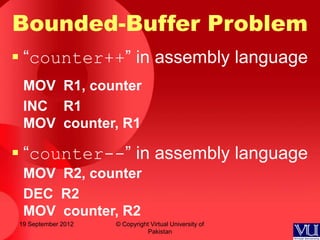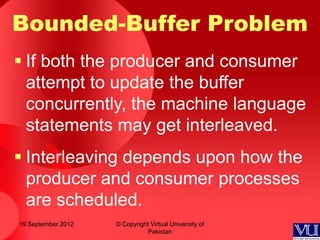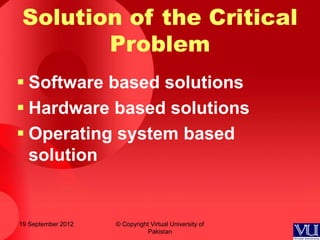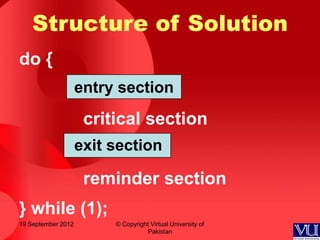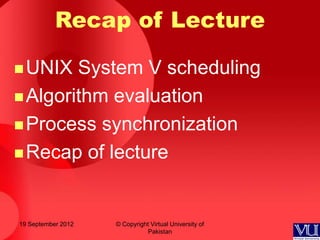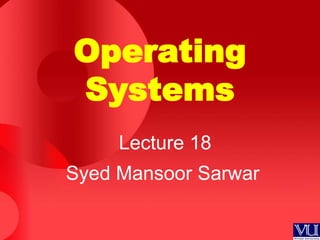os lacture
- 1. Operating Systems Lecture 18 Syed Mansoor Sarwar
- 2. Agenda for Today ïŪ Review of previous lecture ïŪ UNIX System V scheduling ïŪ Algorithm evaluation ïŪ Process synchronization ïŪ Recap of lecture 19 September 2012 ÂĐ Copyright Virtual University of Pakistan
- 3. Review of Lecture 17 ïŪ Multi-level queues scheduling ïŪ Multi-level feedback queues scheduling ïŪ UNIX System V scheduling algorithm 19 September 2012 ÂĐ Copyright Virtual University of Pakistan
- 4. UNIX System V Scheduling Algorithm ï§ Every second, the priority number of all those processes that are in the main memory and ready to run is updated by using the following formula: Priority# = (Recent CPU Usage)/2 + Thr. Pri.+ nice ï§ Threshold priority and nice values are always positive to prevent a user from migrating out of its assigned group 19 September 2012 ÂĐ Copyright Virtual University of Pakistan
- 5. UNIX System V Example PA PB PC CPU CPU CPU Time Priority Count Priority Count Priority Count 60 0 60 0 0 60 0 1 âĶ 60 75 30 60 0 1 1 60 0 âĶ 30 60 2 67 15 75 30 60 0 1 âĶ 30 15 60 3 63 7 67 75 8 30 âĶ 67 30 4 76 33 63 7 8 67 15 âĶ 67 68 19 September 2012 5 16ÂĐ Copyright Virtual University of 76 33 7 63 Pakistan
- 6. Round Robin Scheduling and Process Priorities 60 Higher Priority B B A A A 1 2 3 B A B B A runs first A 19 September 2012 ÂĐ Copyright Virtual University of 4 Pakistan 5 6
- 7. Algorithm Evaluation ï§ Analytic Evaluation ï§ The algorithm and some system workload are used to produce a formula or number which gives the performance of the algorithm for that workload. ï§ Deterministic modeling ï§ Queuing models ï§ Implementation 19 September 2012 ÂĐ Copyright Virtual University of Pakistan
- 8. Deterministic Modeling ï§ Predetermined workload and performance of each algorithm for that workload. Use of Gantt charts. ï§ Simple and fast ï§ Exact numbers for comparison ï§ Requires exact input ï§ Performance figures may not be true in general 19 September 2012 ÂĐ Copyright Virtual University of Pakistan
- 9. Deterministic Modeling ï§ Process Arrival Time Burst Time P1 0.0 7 P2 2.0 4 P3 4.0 1 P4 5.0 4 ï§ Gantt chart P1 P2 P3 P2 P4 P1 0 2 4 5 7 11 16 ï§19Average waiting time =University of1 + 0 +2)/4 = 3 September 2012 ÂĐ Copyright Virtual (9 + Pakistan
- 10. Queuing Modeling ï§ Computer system viewed as a network of queues and servers: ready queue, I/O queue, event queues, CPUs, I/O device controllers, etc. ï§ Input: Arrival and service rates ï§ Output: CPU utilization, average queue length, average waiting time, âĶ 19 September 2012 ÂĐ Copyright Virtual University of Pakistan
- 11. Queuing Modeling Littleâs Formula: n = Îŧ* W where n = average queue length Îŧ = average arrival rate W = average waiting time in a queue 19 September 2012 ÂĐ Copyright Virtual University of Pakistan
- 12. Queuing Modeling Let the average job arrival rate be 0.5 Algorithm Average Wait Average Queue Time Length(n) W=tw FCFS 4.6 2.3 SJF 3.6 1.8 SRTF 3.2 1.6 RR (q=1) 7.0 3.5 RR (q=4) 19 September 2012 6.0 ÂĐ Copyright Virtual University of 3.0 Pakistan
- 13. Queuing Modeling ï§ Complicated mathematics ï§ Distributions (Poisson, uniform, exponential, etc) for the arrival and departure rates can be difficult to work with ï§ Assumptions may not be accurate ï§ Approximation of the real system 19 September 2012 ÂĐ Copyright Virtual University of Pakistan
- 14. Simulation ï§ Programming model for the computer system ï§ Workload generated by assuming some distribution and a random number generator, or by collecting data from the actual system. 19 September 2012 ÂĐ Copyright Virtual University of Pakistan
- 15. Simulation ï§ Characteristics ï§Expensive: hours of programming and execution time ï§May be erroneous because of the assumptions about distributions 19 September 2012 ÂĐ Copyright Virtual University of Pakistan
- 16. Simulation 19 September 2012 ÂĐ Copyright Virtual University of Pakistan
- 17. Implementation ï§ Best ï§ Most expensive ï§ Good option due to Open Source kernels such as Linux 19 September 2012 ÂĐ Copyright Virtual University of Pakistan
- 18. Process Synchronization ï§ Concurrent access to shared data may result in data inconsistency. ï§ Maintaining data consistency requires mechanisms to ensure that cooperating processes access shared data sequentially. 19 September 2012 ÂĐ Copyright Virtual University of Pakistan
- 19. Bounded-Buffer Problem Shared data #define BUFFER_SIZE 10 typedef struct { ... } item; item buffer[BUFFER_SIZE]; int in = 0, out = 0; int counter = 0; 19 September 2012 ÂĐ Copyright Virtual University of Pakistan
- 20. Bounded-Buffer Problem Producer process item nextProduced; âĶ while (1) { while (counter == BUFFER_SIZE) ; buffer[in] = nextProduced; in = (in + 1) % BUFFER_SIZE; counter++; } 19 September 2012 ÂĐ Copyright Virtual University of Pakistan
- 21. Bounded-Buffer Problem Consumer process item nextConsumed; while (1) { while (counter == 0) ; nextConsumed = buffer[out]; out = (out + 1) % BUFFER_SIZE; counter--; } 19 September 2012 ÂĐ Copyright Virtual University of Pakistan
- 22. Bounded-Buffer Problem ï§ âcounter++â in assembly language MOV R1, counter INC R1 MOV counter, R1 ï§ âcounter--â in assembly language MOV R2, counter DEC R2 MOV counter, R2 19 September 2012 ÂĐ Copyright Virtual University of Pakistan
- 23. Bounded-Buffer Problem ï§ If both the producer and consumer attempt to update the buffer concurrently, the machine language statements may get interleaved. ï§ Interleaving depends upon how the producer and consumer processes are scheduled. 19 September 2012 ÂĐ Copyright Virtual University of Pakistan
- 24. Bounded-Buffer Problem ï§ Assume counter is initially 5. One interleaving of statements is: producer: MOV R1, counter (R1 = 5) INC R1 (R1 = 6) consumer: MOV R2, counter (R2 = 5) DEC R2 (R2 = 4) producer: MOV counter, R1 (counter = 6) consumer: MOV counter, R2 (counter = 4) ï§ The value of count may be either 4 or 6, where the correct resultofshould be 5. 19 September 2012 ÂĐ Copyright Virtual University Pakistan
- 25. Process Synchronization ï§ Race Condition: The situation where several processes access and manipulate shared data concurrently, the final value of the data depends on which process finishes last. 19 September 2012 ÂĐ Copyright Virtual University of Pakistan
- 26. Process Synchronization ï§ Critical Section: A piece of code in a cooperating process in which the process may updates shared data (variable, file, database, etc.). ï§ Critical Section Problem: Serialize executions of critical sections in cooperating processes 19 September 2012 ÂĐ Copyright Virtual University of Pakistan
- 27. Solution of the Critical Problem ï§ Software based solutions ï§ Hardware based solutions ï§ Operating system based solution 19 September 2012 ÂĐ Copyright Virtual University of Pakistan
- 28. Structure of Solution do { entry section critical section exit section reminder section } while (1); 19 September 2012 ÂĐ Copyright Virtual University of Pakistan
- 29. Recap of Lecture ïŪ UNIX System V scheduling ïŪ Algorithm evaluation ïŪ Process synchronization ïŪ Recap of lecture 19 September 2012 ÂĐ Copyright Virtual University of Pakistan
- 30. Operating Systems Lecture 18 Syed Mansoor Sarwar

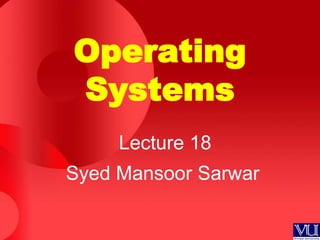


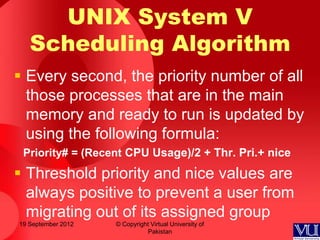
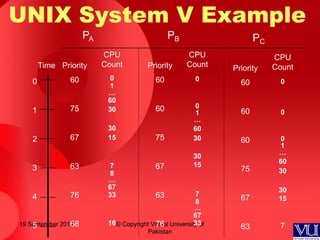

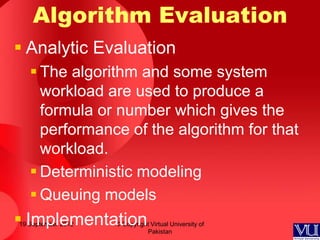
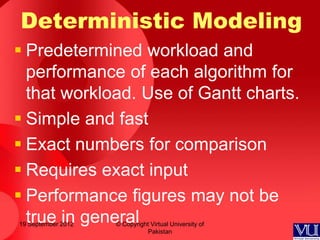
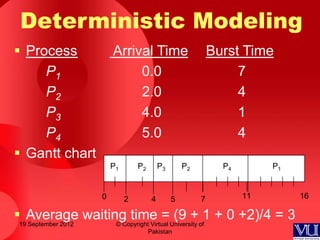
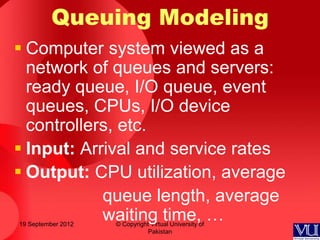
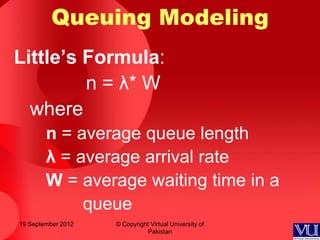
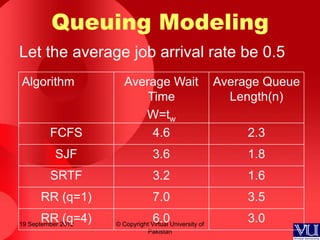
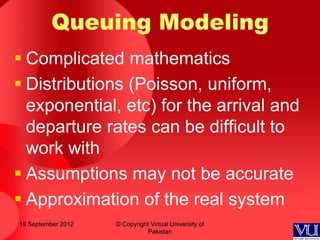

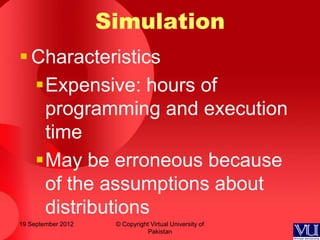

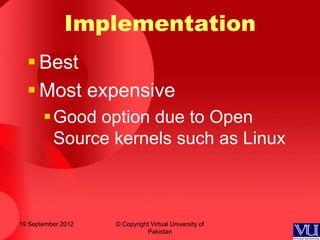
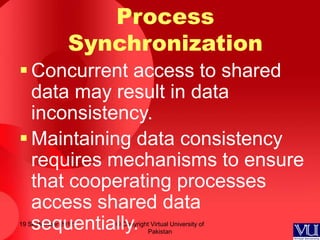
![Bounded-Buffer Problem
Shared data
#define BUFFER_SIZE 10
typedef struct {
...
} item;
item buffer[BUFFER_SIZE];
int in = 0, out = 0;
int counter = 0;
19 September 2012 ÂĐ Copyright Virtual University of
Pakistan](https://image.slidesharecdn.com/lacno5-120919131323-phpapp01/85/os-lacture-19-320.jpg)
![Bounded-Buffer Problem
Producer process
item nextProduced;
âĶ
while (1) {
while (counter == BUFFER_SIZE) ;
buffer[in] = nextProduced;
in = (in + 1) % BUFFER_SIZE;
counter++;
}
19 September 2012 ÂĐ Copyright Virtual University of
Pakistan](https://image.slidesharecdn.com/lacno5-120919131323-phpapp01/85/os-lacture-20-320.jpg)
![Bounded-Buffer Problem
Consumer process
item nextConsumed;
while (1) {
while (counter == 0) ;
nextConsumed = buffer[out];
out = (out + 1) % BUFFER_SIZE;
counter--;
}
19 September 2012 ÂĐ Copyright Virtual University of
Pakistan](https://image.slidesharecdn.com/lacno5-120919131323-phpapp01/85/os-lacture-21-320.jpg)
